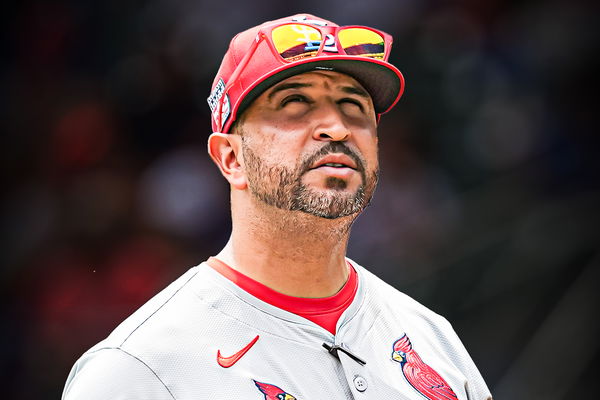
via Imago
Credits: Imago

via Imago
Credits: Imago
It started with a pitch that barely caught dirt—never mind the strike zone. During a 1-0 game featuring the St. Louis Cardinals and the Cincinnati Reds, the atmosphere was charged with excitement as the inning commenced. Masyn Winn confidently awaited the pitch in a full count situation, hoping to earn a walk. The ball came in low and outside. Winn began his trot first. Then came the call: strike one. Gasps filled Great American Ball Park. The momentum didn’t just shift—it imploded.
Cardinals manager Oliver Marmol didn’t explode immediately. He watched, stiff and silent, as the next pitch, equally borderline, was called strike two. That was it.
With determination etched on his face and his gaze fixed on home plate umpire Will Little’s eyes, Marmol stormed out of the dugout with an intensity that transcended the usual disputes managers have with umpires. It was an outburst of pent-up frustration that had been building up for some time. Within seconds, Marmol was tossed. No warnings. No cooldown. Just a ruthless ejection that left the Cardinals without their skipper in a razor-thin contest.
ADVERTISEMENT
Article continues below this ad
Cardinals manager Oliver Marmol ejected!😳 pic.twitter.com/ZkW4432JXo
— Baseball’s Office (@baseballsoffice) April 30, 2025
While Marmol didn’t speak directly to the specific pitch postgame, his actions on the field made his position clear. His ejection marked his second of the season and immediately sparked debate across social media and MLB circles. Many fans pointed to the pitch-tracking graphic, which showed the 3-0 offering clearly outside the zone. For a manager already known for sticking up for his players, especially young ones like Winn, the blowup felt both emotional and intentional.
And let’s be real—this wasn’t an isolated moment. Baseball’s strike zones have become a nightly source of frustration. Whether it’s borderline calls flipping counts or missed balls in tight moments, more and more games are being tilted by inconsistent umpiring.
This one hit a nerve. Marmol’s ejection wasn’t just about that inning—it was about a larger trend. A trend that has players questioning, fans seething, and managers boiling over.
As for the Cardinals? They escaped with a narrow win. But the tension? That’ll last a lot longer.
ADVERTISEMENT
Article continues below this ad
What’s your perspective on:
Is inconsistent umpiring ruining the integrity of baseball, or just part of the game’s charm?
Have an interesting take?
It’s not just Cardinals: Strike zone scrutiny across MLB
Across Major League Baseball, frustrations over inconsistent strike zones are mounting fast. Just ask Jazz Chisholm Jr., who was ejected on April 17, 2025, after a called third strike below the zone sparked a fiery response. He didn’t just argue on the field—he took it online with an expletive-laced social media post during the game. The fallout? A one-game suspension and a league-wide reminder that these calls aren’t just affecting at-bats—they’re igniting tempers and shaping narratives. That same week, Kevin Gausman of the Blue Jays faced an ejection following a performance marked by calls, on balls and strikes which led to a dramatic tumble down the clubhouse stairs as he expressed his frustrations further.
These aren’t isolated moments—they’re part of a growing pattern. Giants pitchers, for instance, have pointed to a sharp decline in high-strike calls, altering game plans and shaking confidence in the current system. Catcher Patrick Bailey, a top framer, has seen a major drop in strike calls on pitches he used to consistently land. The league’s slow push toward an Automated Ball-Strike (ABS) system seems inevitable now, with more players, managers, and fans calling for change.
ADVERTISEMENT
Article continues below this ad
Until that shift comes, though, ejections, viral outrage, and blown counts might remain nightly features of America’s pastime.
ADVERTISEMENT
ADVERTISEMENT
ADVERTISEMENT
ADVERTISEMENT


Is inconsistent umpiring ruining the integrity of baseball, or just part of the game’s charm?